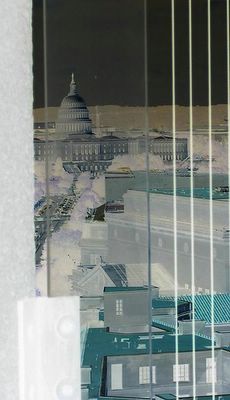ON THE ROAD: Securing Your Yesterdogs
EAST GRAND RAPIDS, Mich. -- As I mentioned yesterday, one place that some consider a necessary stop after last call in Grand Rapids is Yesterdog, a decades-old hot dog landmark on Wealthy Street SE in the Eastown neighborhood. Besides your Taco Bells, 24-hour restaurants and delivery pizza, Yesterdog is one of the few places that serves food past 2 a.m. on the weekends. For us East Grand Rapidians, Yesterdog is just two blocks or so west across the Grand Rapids city limits, so a Yesterdog trip can be easily justified on the way home from bars downtown or in Eastown.
AND ON THE NIGHT BEFORE THANKSGIVING, you're guaranteed to run into someone at Yesterdog that you went to high school with, whether you want to see them or not. (A friend last night ran into an ex-girlfriend from ages ago.) Yesterdog's narrow storefront creates a very crowded situation and the process of ordering, securing and paying for your hot dogs gives the experience instant chaotic credibility -- accented by drunken hungry twentysomethings and miserable Yesterdog clerks who can get easily testy with customers who slow down the process of creating and distributing the best hot dogs in the region.
AT THIS LATE HOUR, while you can order your Yesterdogs, Ultradogs, Chilidogs, etc., there are only two true classifications of hot dogs: legitimate and illegitimate:
Legitimate hot dogs are those ordered and paid for through the unwritten but well-established protocols. A clump of customers, anywhere from five to 15, approach the counter. One of the clerks will take your order. Once the full order of the clump is complete, the full order is assembled with your hot dogs, buns, chili, pickles, onions, etc. At this point, more and more customers pile in waiting to order. The narrow ailse fills with people who either talk, look up at the random knick-knacks from generations past or look at the photo wall, where loyal customers with their Yesterdog t-shirts pose in front of famous places around the globe. Then a large wooden board with all the hot dog goodness is brought over to the counter where clerks will then ask individually what you ordered and give you the hot dogs. Then you pay the clerk operating the ancient cash register with the cash you already have out and ready for transaction. Delays in the process can increase your chances of getting a scowl or a snide comment from one or many of the clerks, especially if it is late at night. Then you go and enjoy your legitimate hot dog.
Illegitimate hot dogs are those secured through backwards or dishonest methods. For instance, last night while I was waiting for a large order to make its way through the process before I could put in my order, a customer from the previous order asked me if I wanted two Ultradogs (chili, chesse, onions, pickels) that were up for grabs. I actually wanted three Ultradogs, but the idea of getting two Ultradogs immediately won me over. I quickly got some money and paid the clerk. Essentially part of the previous order had been botched somewhere in the process and I profited off the situation, not in any sort of financial gain, just in the victory of getting two beloved Ultradogs within two minutes of walking in. I ate my tasty Ultras and then got back in line to order two more Ultras. My friends were quite jealous.
Then you have the sinister way of getting your illegitimate hot dogs. One of my long-time friends, who will remain nameless, employed tactics he used in Iraq as a roving scribe when he walked into Yesterdog late to join me and my other friends. Apparently, people in Baghdad don't like to queue up for anything, so most of the line-up-and-wait situations in the war-torn capital devolve into a Yesterdog-like anything goes feeding frenzy, or so I'm told. The group dynamics of the crowd, plus the lack of firmly established ordering and hot dog securing rules allow a sinister person to delay a legitimate hot dog customer from getting their hot dogs: All you do once an order comes out is casually make your way to the counter, pretend that you were part of the previous mass order and claim two Ultras, or whatever, for yourself. Then you pay for them and go eat. It's that simple, you just steal someone unlucky person' hot dogs for your own selfish desires.
SO AT YESTERDOG, IT'S A DOG EAT DOG WORLD. But this was never expressed in the "American Pie" trilogy. In the movies, there was a hot dog joint the gang hung out at called Dog Years. (The town in the movie is called "East Great Falls" ... East Grand Rapids is just two blocks away.) In the movie, eating hot dogs seems very easy. Hell, you can even have status report meetings about your pre-prom pacts there. But that is during the day when things are less busy. Yesterdog after last call is worth a Hollywood script all on its own.
I have a few photos from Yesterdog that I'll upload to Flickr next week.




